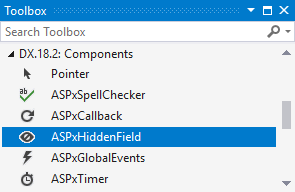ASPxHiddenField Class
Represents a non visual component to store a set of values and synchronize them between the server and client sides across round trips.
Namespace: DevExpress.Web
Assembly: DevExpress.Web.v25.2.dll
NuGet Package: DevExpress.Web
Declaration
public class ASPxHiddenField :
ASPxWebComponent,
IDictionary<string, object>,
ICollection<KeyValuePair<string, object>>,
IEnumerable<KeyValuePair<string, object>>,
IEnumerableRemarks
The ASPxHiddenField component allows you to transfer values between server and client.
Create a Hidden Field
Design Time
The ASPxHiddenField control is available on the DX.25.2: Components toolbox tab in the Microsoft Visual Studio IDE.

Drag the control onto a form and customize the control’s settings, or paste the control markup in the page’s source code.
<dx:ASPxHiddenField ID="ASPxHiddenField1" ClientInstanceName="hiddenField" runat="server">
</dx:ASPxHiddenField>
Run Time
using DevExpress.Web;
...
protected void Page_Load(object sender, EventArgs e)
{
ASPxHiddenField hf = new ASPxHiddenField();
hf.ID = "ASPxHiddenField1";
Page.Form.Controls.Add(hf);
hf.ClientInstanceName = "hiddenField";
}
Imports DevExpress.Web
...
Protected Sub Page_Load(ByVal sender As Object, ByVal e As EventArgs)
Dim hf As ASPxHiddenField = New ASPxHiddenField()
hf.ID = "ASPxHiddenField1"
Page.Form.Controls.Add(hf)
hf.ClientInstanceName = "hiddenField"
End Sub
Note
DevExpress controls require that you register special modules, handlers, and options in the Web.config file. You can change this file or switch to the Design tab in the Microsoft Visual Studio IDE to automatically update the Web.config file. Note that this information is automatically registered if you use the DevExpress Template Gallery to create a project.
Client-Side API
The ASPxHiddenField‘s client-side API is implemented with JavaScript language and is exposed by the ASPxClientHiddenField object.
Availability | Available by default. |
Client object type | |
Access name | |
Events |
Note
The client-side API is always available for this control.
Dictionary Storage
The ASPxHiddenField is a dictionary that maintain an unlimited number of elements (key/value pairs). In a key/value pair, a key is a property name (a string) and a value - a property value (an object). Property names (keys) must be unique. Property names can contain any symbols except for the symbols | and # (the vertical bar and the hash sign).
Supported Value Types
You can store property values of different types in the hidden field.
The hidden field automatically preserves value types and does not require converting values to the required type. It allows you to manipulate the same value type both on the server and client sides.
Synchronization
Use the ASPxHiddenField.SyncWithServer property to specify whether the control synchronizes its values between the client and server sides. Synchronization is in effect when either the control sends a postback or callback. Set the ASPxHiddenField.SyncWithServer property to false when you use the hidden field only to pass values from the server to the client. This minimizes data transfer between the client and the server.
Note
ASPxHiddenField stores all its content in its own hidden input and does not use ViewState. As a result, the ASPxHiddenField’s properties are not automatically available across roundtrips to the client.